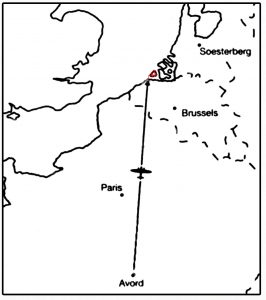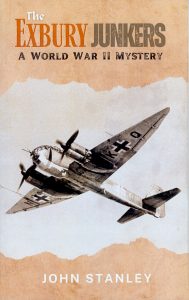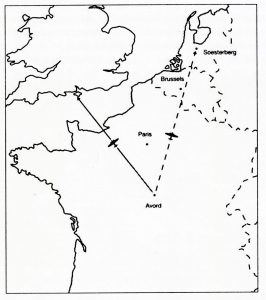11th June: The Exbury Junkers
Summary Explanation: A navigational error resulted in the Junkers flying a compass course of 26°W instead of 26°E. Reaching the Isle of Wight the crew probably thought they were over the Scheldt estuary region of German-held southern Holland and were being fired at by German anti-aircraft installations who had mistaken them for an English plane. Thus they did not fire back but fired red flares to indicate they were a friendly aircraft while they circled and tried to find their position on the map of southern Holland. However, within 10 minutes they were shot down.
The shooting down at Exbury (on 18th April 1944) of a Junkers Ju188 was important inspiration for Nevil Shute’s novel “Requiem for a Wren”. During my visit to Exbury Gardens on a warm, rainy Sunday I noticed that the Gift Shop was selling John Stanley’s book about the incident. I bought a copy on my way out of the gardens, and started reading it while sitting outside “Mr Eddy’s” cafe. One illustration caught my eye. Figure 65 on page 79 of the book is a map showing the intended route from Avord, France, to Soesterburg in Holland and the actual route flown to the Isle of Wight area (see reproduction below).
At first glance the two paths look almost symmetrical about north but John Stanley notes that the intended direction was about 18°T whereas that flown was about 325°T, a total error of about 53°. One suggestion he considers is that the compass was faulty, but that seems much too large an error for a well maintained German plane. John Stanley also suggests that the “observer seems to have been far too experienced to have made a fundamental mistake in calculating the course to take”.
However Avord in France is at 47.03°N 2.65°E and the magnetic declination in 1944 would have been about 8° west of north ( NOAA Historic Magnetic Declination viewer ). That means that the aircraft needed to fly on a course of about (18° + 8°) = 26° east of north as indicated by the plane’s compass. In fact it flew on a course which was about (360° – 8°) – 325° = 27° west of compass north.
While we will never know for certain that flying a compass course of 26°(mag)W instead of 26°(mag)E was what brought the Junkers Ju188 to the IOW, if not it would seem a remarkable coincidence of the numerical values.
So a confusion of east and west, either in setting the auto-pilot or in communicating the course to the pilot, would have been all that was needed to take the plane to the Isle of Wight. The crew were at a foreign airfield in the middle of occupied France and needed to fly to a Dutch airfield some distance to the north. Had the needed course been, say, 60° E then setting 60°W would surely have been an obvious error, but 26° is perhaps close enough to a roughly northwards direction that the mistake might go unquestioned.
I have been on a ship where an experienced navigation officer sent the ship on a reciprocal course, fully 180° in error; tiredness and/or stress can easily result in mistakes being made… and these men were operating in wartime.
Further thoughts: What seemed like mysterious behaviour for a lone German aircraft flying over the IoW and southern Hampshire is not mysterious if the crew actually thought they were flying over German occupied southern Holland. Thinking they were over “friendly” territory and had been mistaken for an English bomber they did not fire back. Instead they fired red flares to try to convince those below that they were a friendly plane which had lost its way. Meanwhile they started a search pattern to try to determine their position. Perhaps the following is a more detailed guess at their thoughts and actions…
English radar had detected them at 07:03 some 15 miles west of Le Havre at around 600ft but they had climbed to 4000ft, a more efficient flying height and above the cloud base while over the channel. By 07:24 they were reported approaching the Isle of Wight. At some point during those 21 minutes they no doubt realised they were over water and would have been trying to work out why. They would have had to assume they were too far west from their intended course. When they reached the IoW coast, dead reckoning (based on the time they had been flying) and the coastline below might have suggested that they had reached the Scheldt River estuary in southern Holland. From that position their intended destination, Soesterberg, would require a course of about 55°T. They initially turned due north, a course correction of 35° further eastwards. Had they actually been flying at their intended 18°T, this would have put them on a course of 53°T, roughly the direction of Soesterberg from the Scheldt estuary.

Where they might have thought they were. The Scheldt Estuary is the same distance from Avord as the IoW. In red is a copy of their track in the IoW area, drawn roughly to scale.
However they would have wondered how they could be so far off track, and why they had been flying over water. They needed to confirm their position. They commenced a circuit over the island below (actually the IoW) to try to relate features on the ground to those marked on their map of Holland. Nothing would make sense. The plane would have had Radio Direction Finding (RDF) equipment on board (Stanley’s book, p.90) but RDF is easiest to use from a roughly known position in order to establish an exact position. You have to choose which radio stations to DF on. It would take time to get an accurate fix when the plane’s actual position was so very far from where the crew thought they were.
But time to establish their position was very short. At 07:30 an anti-aircraft gun started firing at them. Thinking that they were over German occupied territory they would assume that they had been mistaken for an English aircraft. They would have been aware that the underside of the plane had been sprayed black which might make it “difficult to tell whether this was a German or RAF bomber” (Stanley’s book, p.6). So they did not fire back but instead started firing red Very pistol flares to try to indicate that they were a friendly, German aircraft which “had an emergency and needed help” (Stanley’s book, p.82).
They would have wondered at all the ships which they saw assembled in the “Scheldt Estuary” below. Was is a secret German invasion force being prepared to attack England? Meanwhile the fire from one anti-aircraft gun seemed to have caused other anti-aircraft installations to panic and start firing at them. Why couldn’t these people recognise a German plane when they saw one? Could they not see the red Very lights which they were firing?
Everything would have been happening so quickly. It was only a frantic 5 minutes between anti-aircraft guns opening fire and the fatal crash at Exbury. During that time they would have desperately been trying to recognised at least one land feature of southern Holland or get an RDF fix which made any sense. They would have been cursing the “idiots” who were firing anti-aircraft guns at them, despite all their red flares. They did not lower the undercarriage as a sign of surrender, there was no need, they were flying over “friendly” territory.
It was only when they were attacked by two RAF Typhoons were they reported possibly to have fired back. They would have recognised the Typhoons as enemy planes, and assumed the Typhoons must be on a mission over Holland. Finally, all the damage sustained by the plane caused them to crash. They came down at about 07:35; the crew probably still believed they had been flying over German occupied Dutch territory.
But… what does not fit? For example, why were fighters not scrambled specifically to intercept the Junkers? The message to the Royal Observer Corps HQ in Winchester (Stanley’s book, p.2) that a plane “would be flying over the IoW, and no offensive action would be taken” is very puzzling. Possibly this order was given by someone who had decided that the lone plane, detected to be approaching in daytime without fighter escort, must be a defector. I suspect we will never know…. some mysteries remain!
[Acknowledgement: the facts on which this is based come from The Exbury Junkers – A World War II Mystery, John Stanley (2023, 2004), Woodfield Publishing Ltd.,138pp.]


